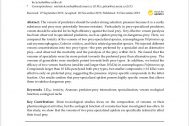Content
The venom of predators should be under strong selection pressure because it is a costly substance and prey may potentially become resistant. Particularly in prey-specialized predators, venom should be selected for its high efficiency against the focal prey. Very effective venom paralysis has been observed in specialized predators, such as spiders preying on dangerous prey. Here, we compared the toxicity of the venoms of two prey-specialized species, araneophagous Palpimanus sp. and myrmecophagous Zodarion nitidum, and their related generalist species. We injected different venom concentrations into two prey types—the prey preferred by a specialist and an alternative prey—and observed the mortality and the paralysis of the prey within 24 h. We found that the venoms of specialists were far more potent towards the preferred prey than alternative prey. The venoms of generalists were similarly potent towards both prey types. In addition, we tested the efficacy of two venom fractions (smaller and larger than 10 kDa) in araneophagous Palpimanus sp.
Compounds larger than 10 kDa paralyzed both prey types, but smaller compounds (<
10 kDa) were effective only on preferred prey, suggesting the presence of prey-specific compounds in the latter fraction. Our results confirm that prey-specialized spiders possess highly specific venom that allows them to subdue dangerous prey.
Compounds larger than 10 kDa paralyzed both prey types, but smaller compounds (<
10 kDa) were effective only on preferred prey, suggesting the presence of prey-specific compounds in the latter fraction. Our results confirm that prey-specialized spiders possess highly specific venom that allows them to subdue dangerous prey.



